

State of the World’s Forests 2003. 2003. Rome, FAO. ISBN 92-5-104865-7.
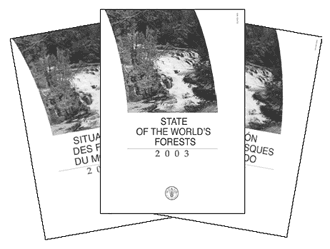
The biennial State of the World’s Forests – now in its fifth edition – presents a global picture of the forest sector, providing up-to-date information on activities and institutional developments as well as highlighting challenges and opportunities related to some key issues. State of the World’s Forests 2003 includes contributions from key intergovernmental and non-governmental organizations and from individuals contributing in their own personal capacity, in addition to pieces prepared by FAO. Such a mix is consistent with the theme of the 2003 edition – “partnerships in action”.
An effort has been made to cover many subjects that are especially relevant to discussions taking place in international fora today. Part I presents recent developments and areas of current attention as regards forest resources; the management, conservation and sustainable development of forests; the institutional framework; and the international forest policy dialogue. Part II contains five chapters, each addressing a particular subject in more detail:
The State of the World’s Forests is published in Arabic, Chinese, English, French and Spanish, and is available electronically in these five languages on the FAO Forestry Web site (www.fao.org/forestry/sofo). This publication will prove a useful reference tool for policy-makers, foresters and other interested readers seeking an up-to-date view of the major issues involving the forest sector today.
Forestry Outlook Study for Africa: Regional report – opportunities and challenges towards 2020. FAO Forestry Paper No. 141. 2003. Rome, FAO. ISBN 92-5-104910-6.
African forests: a view to 2020. 2003. Rome, FAO. ISBN 92-5-004913-7.
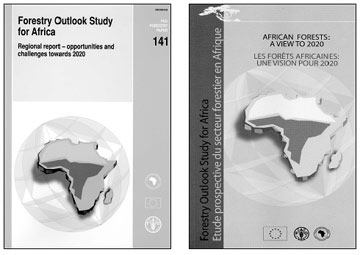
African forests fulfil critical environmental, economic, social and cultural functions, whose relative importance to society is shifting as the continent undergoes rapid political, economic and social transition.
The Forestry Outlook Study for Africa (FOSA) was carried out to indicate what is likely to happen to the forest sector in Africa in the next two decades, and to identify the priorities and strategies that may be pursued to enhance forestry’s contribution to sustainable development and to societal welfare. It is one of a series of regional outlook studies undertaken by FAO in partnership with countries and institutions concerned with forestry in the region.
The main output of the study is the regional report, published separately in English and French. In addition, five subregional reports, available on the FOSA Web site (www.fao.org/forestry/fosa), provide in-depth assessment of emerging changes for Central, East, North, Southern and West Africa.
African forests: a view to 2020, a bilingual summary report, provides a synthesis of the key findings from the regional and subregional reports for a general audience.
The FOSA regional report outlines the potentials and challenges for enhancing the contribution of the forest sector to Africa’s sustainable development, taking into account the projected policy, institutional, demographic, economic, technological and environmental changes. Analysing the impact of driving forces both within and external to the sector, and examining probable scenarios, it gives an indication of what may happen up to 2020 if present trends persist.
Currently, forests and forestry in Africa confront a number of problems, including a rapid decline in forest cover, loss of biological diversity and a variety of unsustainable uses that cast uncertainty on the future flow of goods and services. The report summarizes the main factors that will affect African forestry, including:
To take such factors into consideration, priorities will have to shift in favour of the inseparable objectives of:
The regional review outlines the following strategies:
More than providing a set of numbers, the aim of FOSA was to catalyse the process of looking ahead. The knowledge base provided by the study and its published reports will contribute to initiatives such as the National Forest Programme Facility.
Natural resource conflict management case studies: an analysis of power, participation and protected areas. A.P. Castro and E. Nielsen, eds. 2003. FAO, Rome.
Community-based forest resource conflict management – a training package. K. Means, C. Josayma, E. Nielsen and V. Viriyasakultorn. 2002. 2 vols. FAO, Rome.

FAO’s activities in natural resource conflict management focus on supporting diverse stakeholders in managing the conflicts that inevitably arise in the protection, use and control of forests and other natural resources.
Natural resource conflict management case studies: an analysis of power, participation and protected areas is a collection of studies that collectively portray the general trends in the field. The cases represent a wide range of sectoral, ecological and regional settings (five from Africa, five from Asia and two from the Americas). Examples include conflicts between urban and rural residents over the management of watersheds, between large- and small-scale agricultural producers over land, between members of different communities over the use of forests, and between villagers and government officials over access to, and use of, protected areas.
The case studies illustrate many strategies, methods and tools used in natural resource conflict management and resolution, including indigenous/local practices, legal systems and alternative approaches. In most of the cases more than one approach is used. The cases often involve a wide range of interested parties, including, in addition to forest communities, governments, corporations, non-governmental organizations and technical assistance agencies.
Each case study provides an in-depth analysis of the strategies, processes and tools used by different stakeholders to address the conflict(s). The studies also include questions and discussion prompts for use by trainers and educators.
The cases will be of interest not only to specialists, educators and trainers in the field of conflict management, but also to a broader audience that includes policy-makers, project and programme managers and staff, extension officers, researchers and others.
This publication complements the training materials package Community-based forest resource conflict management, developed by FAO in collaboration with the Regional Community Forestry Training Centre, based in Bangkok, Thailand. The training package aims to support diverse and multiple forest user groups in resolving conflicts and to strengthen participation, by:
The two-volume package provides background information, training activities, case studies, workshop aids, instructions on workshop design and bibliographic references for preparing and supporting trainers in conflict management.
Reforming government policies and the fight against forest crime. Proceedings of an informal expert meeting, Rome, 14-16 January 2002. 2002. Rome, FAO.
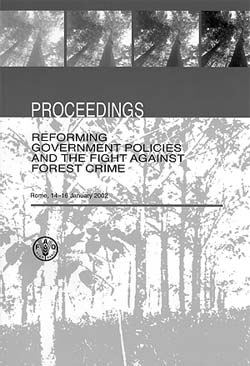
Forest crime – including activities such as unauthorized occupation of forest land, arson, illegal logging and unauthorized processing, transport and smuggling of forest products – has negative environmental, economic and social consequences. In particular, it hurts the poor and deprives governments of much-needed revenues that could be used to support sustainable forest management. It also reduces the value of forest resources, thus making their conservation and appropriate management commercially unattractive.
Because financial gains from illegal activities are higher than those involving the use of sustainable and legal practices, the future of sustainable forest management is in doubt in those countries, unfortunately numerous, that are unable or unwilling to control forest crime.
FAO provides advice to countries on policy reforms that could help national efforts to improve governance in the forest sector and reduce forest crime. In January 2002, FAO held an expert consultation on the subject to identify the strategic options for policy reform that show the most promise for controlling illegal activities in the forest sector. These options need to go beyond technical solutions to tackle the more intractable political, cultural and social factors.
This publication contains the proceedings and background documentation of the expert consultation. It presents an extensive list of suggested actions for reducing forest crime and enhancing forest law compliance. The list is separated into actions specific to different groups of actors, including governments, local communities, forest industry, forest product retailers, consumers, certification bodies, non-governmental organizations, financing agencies, and several others. The background documentation includes papers on policy and legal options to improve law compliance; a legal perspective on illegal activities in the forest sector; and forest certification and forest law compliance.
The proceedings are also available online at: www.fao.org/DOCREP/005/Y4182E/Y4182E00.HTM
Acacia spp. FAO/IPGRI Technical Guidelines for the Safe Movement of Germplasm No. 20. K.M. Old, T.K. Vercoe, R.B. Floyd, M.J. Wingfield, J. Roux & S. Neser. 2002. Rome, FAO/International Plant Genetic Resources Institute. ISBN 92-9043-524-0.
Pinus spp. FAO/IPGRI Technical Guidelines for the Safe Movement of Germplasm No. 21. M. Diekmann, J.R. Sutherland, D.C. Nowell, F.J. Morales & G. Allard, eds. 2002. Rome, FAO/International Plant Genetic Resources Institute. ISBN 92-9043-525-9.
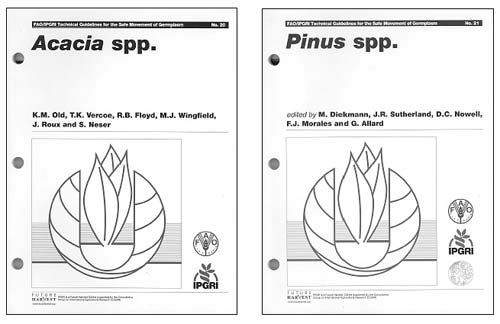
Complete and current phytosanitary information is essential for any international movement of plant germplasm. Preventive measures and effective testing procedures are required to minimize the risk of accidental introduction of plant pests.
The International Plant Protection Convention (IPCC) is internationally recognized as the legal instrument and primary vehicle for international cooperation in the protection of plant genetic resources from pests. IPPC also seeks to harmonize phytosanitary measures affecting international trade. As the depository of IPPC, FAO collaborates with the International Plant Genetic Resources Institute (IPGRI) to ensure and facilitate the safe movement of plant germplasm for research purposes, by identifying technically sound practices that safeguard against the introduction and establishment of unwanted pests.
The major output of this collaborative work is a series of crop- or plant-specific technical guidelines, FAO/IPGRI Technical Guidelines for the Safe Movement of Germplasm. These guidelines, produced by panels of experts on the crop or plant concerned, provide relevant technical information for the detection and recognition of pests of potential phytosanitary importance to prevent their involuntary international dissemination. The recommendations made in the guidelines are intended for small, specialized consignments used in research programmes, e.g. for collection, conservation and utilization for breeding of plant genetic resources.
The most recent publications in the series deal with Pinus and Acacia spp. Both publications provide detailed descriptions and colour photographs of diseases and insect pests affecting the genus.
The publications are also available online, free of charge, at: www.ipgri.cgiar.org/publications/guideline.htm
Stakeholder incentives in participatory forest management – a manual for economic analysis. M. Richards, J. Davies, & G. Yaron. 2003. London, UK, Overseas Development Institute, ITDG Publishing. ISBN 1-85339-559-5.
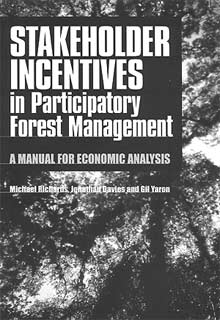
Participatory approaches are being increasingly recognized as essential to the success and sustainability of forest management. However, a factor that sometimes prevents small farmers and foresters from participating in forestry projects is their poor understanding of the costs and benefits of their participation.
Stakeholder incentives in participatory forest management provides practical methodological guidance for the economic analysis of stakeholder incentives for participating in forest management. Designed for professionals working in forestry projects, it provides practical economic tools that can be used to enable small farmers and foresters to analyse their situations and identify solutions to their problems. It gives readers practical advice on how to conduct activities such as workshops and surveys that incorporate simple economic tools.
Part I introduces the economic concepts applied to participatory forest management. It can serve as a refresher to economists working in the field, and it makes economics more understandable for others involved in promoting participatory forest management such as social development advisers, social foresters, project managers and donor advisers.
Part II contains the economic stakeholder analysis toolbox. The tools are organized into six main stages: characterizing stakeholders; understanding the decision-making context; quantifying costs and benefits; valuing costs and benefits; comparing the economics of alternative decisions; and participatory analysis and monitoring. An important aim in the economic stakeholder analysis framework is to integrate economic analysis with other decision-making criteria, including social and institutional analysis.
This user-friendly publication also presents over 30 examples of the practical application of economics in local forestry situations in Africa, Asia and Latin America.